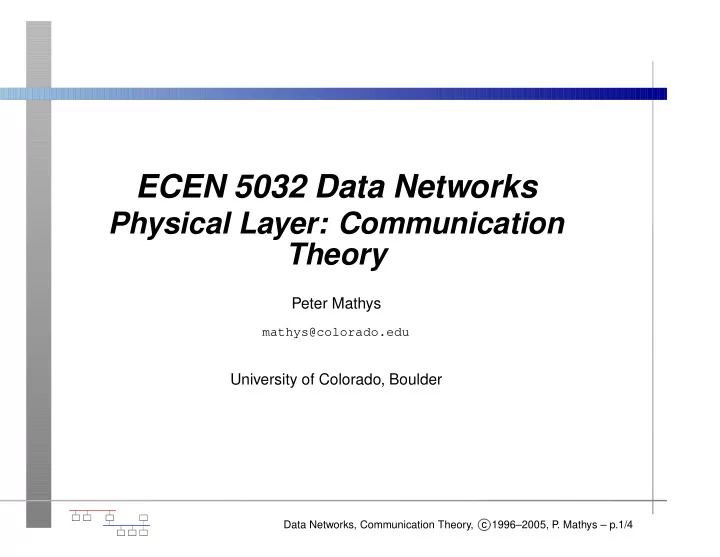

� ECEN 5032 Data Networks Physical Layer: Communication Theory Peter Mathys mathys@colorado.edu University of Colorado, Boulder Data Networks, Communication Theory, c 1996–2005, P . Mathys – p.1/4
✡ ✝ ☎ ✞ ✍ ✏ ✟ ☞ ☛ ✝ ✆ ✟ ✟ ✠ ✍ ☛ ✆ ✎ ✠ ✄ � ✞ ✎ ✝ ✟ ✟ ✡ ✡ ☎ ☛ ✞ ✠ ✟ ✟ Communication System ✡✂✌ �✂✁ ☎✆✂✝ ☎✆✂✟ �✂✁ ✆✂✝ �✂✁ ✡✂✌ �✂✁ Data Networks, Communication Theory, c 1996–2005, P . Mathys – p.2/4
� � � Communication System Blocks Source can be analog (e.g., voice, music) or digital (e.g., computer data, WAV file). Source Coding compresses source signal by removing redundancy (e.g., WAV MP3, JPEG, MPEG). May also include A/D conversion. Secrecy Coding transforms compressed source signal using secret key. Only recipient with key can recover source signal. Channel Coding adds redundancy with the goal of detecting and/or correcting transmission errors. Modulator changes input signal into a form suitable for transmission over channel. E.g., Digital analog, and/or baseband to bandpass. Data Networks, Communication Theory, c 1996–2005, P . Mathys – p.3/4
� � � Communication System Blocks Channel is characterized by passband with bandwidth , input power limitation, and noise SNR (signal-to-noise ratio), fading. Fading is change of signal strength, caused by intersection of several radio waves from the same source arriving along different propagation paths. Data Networks, Communication Theory, c 1996–2005, P . Mathys – p.4/4
Recommend
More recommend